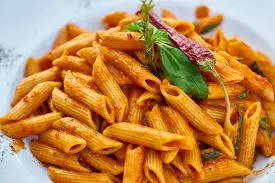Can a Dog Eat Pasta? A Comprehensive Guide for Pet Owners
Dogs are known for their eager curiosity when it comes to food, Pasta often eyeing whatever their humans are eating with great interest. One question pet owners frequently ask is whether pasta is safe for their furry companions. This guide will explore whether pasta has a place in a dog’s diet, the benefits and risks associated with it, and how to serve it safely if you choose to give it as an occasional treat.

Is Pasta Safe for Dogs?
Yes, pasta is generally safe for dogs to eat in moderation, as long as it’s plain and cooked. Traditional pasta, made from flour, eggs, and water, doesn’t contain any ingredients that are toxic to dogs. While pasta doesn’t offer much in terms of essential nutrients, it can be a source of energy for dogs due to its carbohydrate content. However, moderation is key. Because dogs primarily rely on a balanced diet that includes protein, vitamins, and other nutrients, pasta should not replace their regular food but can be used as an occasional treat.
Nutritional Profile of Pasta
Pasta is primarily a carbohydrate-based food, which provides energy but lacks the protein and fats that are essential for a dog’s health. Here’s a quick look at what pasta offers nutritionally:
- Carbohydrates: Pasta is rich in carbohydrates, which offer quick energy. While dogs don’t need a large amount of carbohydrates, small amounts can be beneficial, particularly for active dogs.
- Minimal Fat: Plain pasta is low in fat, making it a relatively harmless addition in small portions, especially for dogs who need to avoid fatty foods.
- Vitamins and Minerals: While pasta does contain some trace amounts of iron, folic acid, and B vitamins, these nutrients are in very small quantities, so they don’t offer substantial benefits to a dog’s health.
Overall, pasta lacks the balanced nutrients that a dog needs, meaning it should only be an occasional treat rather than a regular part of a dog’s diet.
How Much Pasta is Safe for Dogs?
Since pasta is an occasional food, the serving size should be small. For small dogs, a tablespoon or two of cooked pasta is sufficient. For larger dogs, a quarter to half a cup of pasta can be served as a treat, mixed in with their regular food. Overfeeding pasta can lead to weight gain, as it is calorie-dense but lacks substantial nutrients. Too many carbohydrates can also contribute to digestive issues or make a dog sluggish if consumed in large amounts.
Types of Pasta: What’s Best for Dogs?
While standard pasta is generally safe, different types can have varying effects on a dog’s digestion:
- Plain Pasta: Traditional white or whole-wheat pasta is the safest option. It’s best to stick to simple, cooked pasta without added ingredients.
- Whole-Wheat Pasta: Whole-wheat pasta has more fiber and can be a better choice for dogs with sensitive stomachs. However, too much fiber can cause digestive issues for some dogs, so start with small amounts.
- Gluten-Free Pasta: Some dogs may have sensitivities to gluten, making gluten-free pasta an alternative option. These pastas are typically made from rice, chickpeas, or lentils, but it’s essential to ensure no added flavors or seasonings are included.
- Flavored or Filled Pasta: Avoid pasta that contains seasonings, garlic, onions, or fillings like cheese or spinach. Ingredients like garlic and onions are toxic to dogs and can cause serious health issues.
How to Serve Pasta to Dogs Safely
If you decide to offer pasta as a treat for your dog, follow these guidelines to ensure it’s served safely:
- Cook It Thoroughly: Raw pasta is difficult to digest, so make sure it’s fully cooked and soft. Raw or undercooked pasta can expand in the stomach, potentially causing digestive discomfort.
- Avoid Seasonings and Sauces: Pasta should be served plain. Sauces often contain ingredients like garlic, onions, salt, and fats that can be harmful to dogs. Even tomato sauce can upset a dog’s stomach due to its acidity.
- Limit Serving Size: Offer only a small amount of pasta, mixed in with regular dog food if desired. Too much pasta can overwhelm a dog’s system, leading to digestive issues or weight gain.
- Watch for Allergies: Some dogs may have an allergy to grains or gluten, resulting in symptoms like itching, redness, or stomach upset. Start with a small amount and observe for any adverse reactions.
When Pasta Can Be Useful for Dogs
In some specific cases, pasta can actually be beneficial for dogs:
- As a Treat for Underweight Dogs: For dogs who need to gain weight, pasta can be added in small amounts to boost caloric intake without adding excessive fat.
- High-Energy Dogs: Active or working dogs who need more carbohydrates for energy may benefit from a small serving of pasta as an occasional boost.
- As a Bland Meal Option: Plain pasta, combined with boiled chicken, can serve as a temporary bland diet for dogs recovering from an upset stomach. This should only be done under veterinary guidance and not for extended periods.
Potential Risks of Feeding Pasta to Dogs
While pasta is generally safe, there are a few risks associated with feeding it to dogs:
- Weight Gain: Pasta is high in calories but lacks essential nutrients, meaning it can contribute to weight gain if overfed. This can lead to obesity, which increases the risk of other health issues, such as joint problems and diabetes.
- Allergies or Sensitivities: Some dogs may be sensitive to wheat or gluten, leading to allergic reactions that may include itching, digestive upset, or even respiratory issues. If your dog shows any symptoms after eating pasta, avoid feeding it again and consult with a veterinarian.
- Digestive Upset: Pasta is not a natural part of a dog’s diet and may cause gas, bloating, or other digestive issues if given in large quantities. Dogs with sensitive stomachs or a history of gastrointestinal issues may not tolerate pasta well.
- Nutritional Imbalance: Dogs require a balanced diet rich in protein, vitamins, and healthy fats. Relying on pasta or other carb-heavy foods too often can dilute their intake of these essential nutrients, potentially leading to deficiencies over time.
Alternatives to Pasta for Dogs
If you’re looking for variety or want a different carbohydrate source for your dog, there are other safe options to consider:
- Sweet Potatoes: High in fiber, vitamins, and antioxidants, sweet potatoes can be an excellent carbohydrate source for dogs.
- Rice: Plain, cooked rice is a safe, easily digestible option often recommended for dogs with sensitive stomachs.
- Pumpkin: Known for its digestive benefits, pumpkin provides fiber and vitamins that support overall gut health.
- Oats: Plain oats are a good source of fiber and can be beneficial for dogs with digestive issues, as long as they’re served in moderation.
Signs of Pasta-Related Issues to Watch For
If your dog eats pasta for the first time, it’s wise to observe them for any potential adverse reactions. Common signs that pasta may not agree with your dog include:
- Gastrointestinal Upset: Vomiting, diarrhea, or excessive gas may indicate that the pasta is not sitting well.
- Lethargy or Sluggishness: Too many carbs can make some dogs feel sluggish or lethargic, particularly if they’re not used to eating carbohydrate-rich foods.
- Allergic Reactions: Itching, swelling, or respiratory issues could be a sign of an allergy. In this case, discontinue feeding pasta and seek veterinary advice.
Final Thoughts: Pasta as an Occasional Treat
In conclusion, pasta can be an occasional treat for most dogs if served in small portions, cooked plainly, and without any additives. Although pasta lacks the balanced nutrients dogs require, it can provide a mild energy boost and some variety to their diet. As always, moderation is crucial to prevent weight gain and avoid any potential digestive upset. For any questions about incorporating new foods like pasta into your dog’s diet, consulting a veterinarian ensures that your dog’s health and dietary needs are prioritized.
